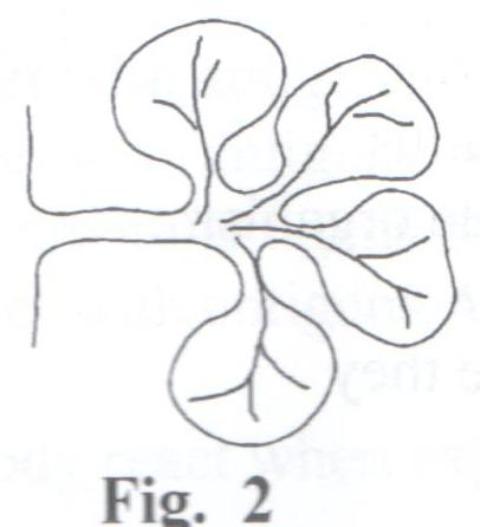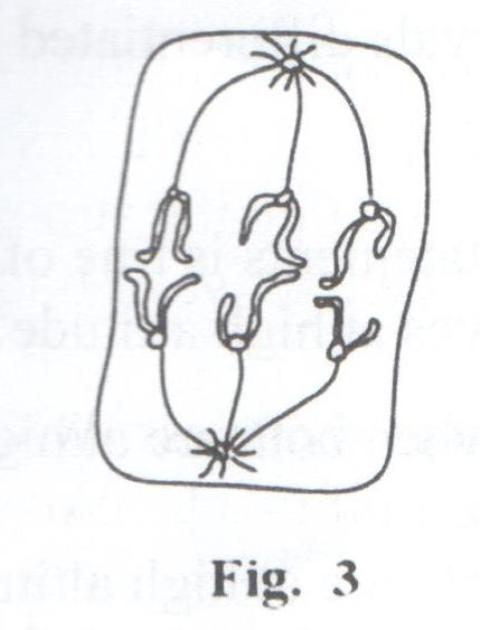1. Which one of the following statements correctly describes the situation illustrated in the pyramid of numbers in figure 1?

- There are fewer primary consumers than secondary consumers
- Secondary consumers are smaller in size than primary consumers
- The producers represent grasses
- There are fewer secondary consumers than primary consumers.
2. Which one of the following comparisons of a sexual and sexual reproduction is not correct?
|
Asexual reproduction |
Sexual reproduction |
|
A. No variation in offspring B. No gametes involved C. Causes rapid increase in number D. Produces more resistant offspring |
Variation in offspring Gametes involved
|
3. Which one of the following is a pair of respiratory organs in amphibians?
- Lungs and spiracles
- Spiracles and gills
- Gills and lungs
- Skin and spiracles
4. Iodised table salt is eaten in order to
- strengthen bones
- avoid developing goiter
- get a balanced diet
- avoid developing high blood pressure
5. Which one of the following is a set of bones found in the human fore limb only?
- Femur, tibia, humerus
- Humerus, radius, ulna
- Femur, radius, ulna
- Tibia, fibula, humerus
6. Which one of the following is the correct sequence of the nitrifying action in the nitrogen cycle?
- Ammonium salts → nitrites → nitrates
- Nitrates → nitrites → ammonium salts.
- Nitrites→ nitrates → ammonium salts
- Nitrates →ammonium salts →nitrites
7. Which one of the following sets of materials is received by a pregnant mother from the foetus?
- Carbon dioxide and glucose
- Amino acids and urea
- Urea and carbon dioxide
- Glucose and amino acids.
8. Tissue respiration is important in living organisms because it
- liberates water and carbon dioxide for excretion.
- causes the breathing in oxygen and breathing out of carbon dioxide.
- enables the removal of nitrogenous wastes
- liberates energy for body metabolism.
9. Which one of the following is correct about a planet when placed in a strong salt solution? It becomes
- turgid because water moves into the cell
- flaccid because water moves out of the cell
- turgid because water moves out of the cell
- flaccid because water moves into the cell.
10. Which one of the following may result from insufficient secretion from the pancreas in an individual?
- Increased level of blood sugar
- Decreased level of digestion of sucrose
- Development of diabetes insipidus
- Inability to digest maltose
11. Plants do not need special excretory organs because they
- eliminate their wastes instantly.
- produce only gaseous wastes.
- produceless toxic wastes slowly
- do not produce wastes.
12. Which one of the following characteristics of parasites would increase their chances of survival?
- Causing severe harm to the host
- Using more than one type of host
- Being highly specific
- Having a membraneous cuticle
13.Which one of the following is not a benefit of fruit and seed dispersal?
- Reducing competition for nutrients
- Ensuring colonization of new habitats
- Increase chances of survival
- Reduction in transmission of diseases
14. Which one of the following activities does not cause environmental pollution?
- Releasing of products of photosynthesis into the atmosphere
- Use of pesticides and artificial fertilizers on farms
- Release of industrial waste into the atmosphere
- Releasing industrial waste into water bodies
15. In plants, tallness is dominant to shortness. What will be the propotion of short plants among the offspring if two heterozygous tall plants are crossed?
- 1
- ½
- ⅓
- ¼
16. In an experiment to determine the amount of humus in a soil sample, the following results were obtained.
Mass of dish = 50g
Mass of dish + dry soil = 200g
Mass of dish + soil after heating to redness = 170g
The percentage of humus in the soil sample was
- 15%
- 20%
- 25%
- 75%
17.The type of plant leaf shown in figure 2 is

- compound palmate
- compound pinnate
- simple palmate
- simple pinnate
18. Which one of the following changes occurs in the eye when a person reading abook looks up to view a distant house?
- The ciliary muscle relaxes
- The radial muscles of the iris ontract
- The lens becomes thick
- The pupils become smaller
19.Which one of the following stages of mitosis is represented in figure 3?

- Telophase
- Prophase
- Anaphase
- Metaphase
20.Which one of the following foetal blood vessels carries the most oxygenated blood?
- Anterior vena cava
- Umbilical artery
- Posterior vena cava
- Umbilical vein
21. Which one of the following is not correct about tropic response? It is
- directional
- result of growth
- caused by external stimulus
- a movement of the whole organism
22. Humans are mammals because they
- suckle their young
- have a blood transport system
- have body muscles for movement
- breath by means of lungs
23. Which one of the following occurs during exhalation in a mammal?
- Diaphragm flattens
- Volume of the thorax increases
- External intercostals muscles relax
- Diaphragm muscles contract
24. A tip of bean root was marked with black ink at uniform intervals. After 3 day, it was noted that some intervals were longer than others. The conclusion from this is that,
- the ink accelerated growth in some parts of the root tip.
- there was no growth in some parts of the root tip
- the rate of cell elongation in parts of the root tio is not uniform
- cells in the longer intervals differentiated more than those in short intervals
25. Which one of the following statements is true of a person who lives at sea level compared to one who lives at high altitude? The one at sea level
- breathes more slowly when both are at high altitude
- has more blood vessels
- breathes faster when both are at high altitude
- has more red blood cells
26. The following is a food chain
Green algae →mosquito larvae→ small fish→big fish→crocodiles
Which one of the following changes would cause a reduction in the number of mosquito larvae?
- Increase in the number of algae
- Increase in the number of crocodiles
- Increase in the number of big fish
- Decrease in the number of small fish
27. Which one of the following reactions is likely to occur when a person of blood group A donates blood to a person of blood group B?
- Antibodies a would react with antigens A
- Antibodies b would react with antigens A
- Antibodies a would react with antigens B
- Antibodies b would react with antigens A and B
28. How would a naked human body react when exposed to a temperature of 250C of 2 hours?
- The body temperature would be lowered to 250C
- Hairs on the skin surface would be lowered
- Vasoconstriction would occur
- More blood would flow near the skin surface
29. Which one of the following is not an adaptation of plant leaves to photosynthesis?
- Possession of chloroplasts
- Presence of intercellular spaces
- Being hairy
- Having a thin lamina
30. Which one of the following pairs of nutrients consists of disaccharides only?
- Glucose and galactose
- Maltose and lactose
- Fructose and sucrose
- Sucrose and glucose.
SECTION B
Answer all questions in this section.
31. In 1905 the number of lions reduced in a park after their relocation to other parks. The number of kobs in the park was then monitored and their estimated numbers recorded for the years 1905 – 1937. The results are shown in Table 1. Study the information and answer the questions that follow.
|
Year |
1905 |
1910 |
1915 |
1920 |
1925 |
1927 |
1930 |
1932 |
1935 |
1937 |
|
Number of Kobs |
1000 |
2200 |
5350 |
9500 |
12200 |
6200 |
3000 |
1500 |
980 |
1020 |
a) Draw a graph to represent the information in Table 1
b) Describe how the population of the kobs varied with time
c) Suggest two reasons that could have caused the change in the kobs population
- from 1905 – 1925
- from 1925 – 1937
d i) From the data, suggest the approximate number of kobs that could be sustained in the park naturally.
e) Give reason for your answer
32. a) State ways by which fish may lose stability
b) Name the fins responsible for preventing each of the forms of instability stated in (a).
c) How does a bony fish swim
- from a low level to a high level?
- forward?
33. An experiment was carried out using a potted plant as shown in the set up in figure 4. Study the figure and answer the questions that follow.

a) Suggest the aim of the experiment.
b) State the role of each of the following substances used in the experiment.
- Soda lime in A
- Lime water in jar B
c) Explain what was observed in jar B and jar D
d) Explain why
- jar C was painted black
- the pot containing the plant was enclosed in a polythene bag.
SECTION C
Answer two questions from this section
34. a) Describe how the amount of light entering the eye is controlled
b) Explain how each of the following parts of the eye is adapted to its function.
- Retina
- Choroid
- Lens
35. a) What is transpiration?
b) Explain how a plant benefits from transpiration
c) Explain why some plants may dry out in water logged soils
36. a) Outline the differences between mitosis and meiosis in nature
b) Explain the importance of mitosis and meiosis in nature
37. a) i) What is vegetative propagation?
ii) Outline the different methods of artificial vegetative propagation, giving examples of plants used in each method named.
b) Give the advantages and disadvantages of vegetative propagation to a plant.
